Tribes 2 Preview
After a few minutes with the alpha build, Tribes 2's improvements over the original become instantly apparent.
In 1998, Starsiege: Tribes took online gaming a step forward - it was the first online-only action game that brought team-focused competitive play to the commercial mainstream. Now, a year after id Software and Epic Games both released popular multiplayer-focused shooters, Dynamix is back with a new ode to squad combat: Tribes 2. The sequel takes a huge step forward in its graphics technology and command interface, yet it should still seem very similar to the original game. In addition to the range of gameplay improvements that will be described in the following pages, Dynamix will add to Tribes 2 a full suite of Internet tools intended to build a team community right into the game application itself. We'll take a closer look at these community tools - including instant messaging, e-mail, forums, and automatic web pages for new teams - when the game reaches beta in several weeks. In the meantime, we have a major update on the progress of Tribes 2.
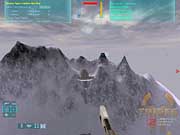
The most striking change in Tribes 2 is that the graphics have been completely overhauled since the game was first shown at the E3 1999 trade show. Looking out across a Tribes 2 map, you'll see an impressive vista filled with sharp peaks, clouded skies that filter sunlight, and natural-looking terrain textures. To achieve such subtle realism, the ground terrain is generated with a fractal system that seamlessly blends together different material types so that a hillside can gradually go from grass to barren rock to snow-packed peaks at higher elevations. The new engine allows for much more rugged terrain, which means that knowing the lay of the land will be even more important when you plan an attack. Dynamic weather effects and environmental obstacles will also come into play - you'll have to deal with snow, rain, lightning strikes, lava lakes, and quicksand.
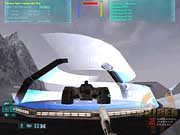
Though Dynamix has intentionally retained many of the elements of the original game, Tribes 2 takes a number of steps to improve the gameplay. Some of the most noticeable changes include improved inventory management, command interface, and vehicles. In both Tribes 2 and its predecessor, you must choose your personal loadouts of arms and armor to match your role on the team. After choosing from one of the three basic soldier classes - light, medium, and heavy - you further personalize your equipment by selecting three weapons, a special equipment pack, and other items. In Tribes, it was necessary to make these selections in real time while you were in front of the inventory station - a situation that could have left a line of veterans exasperated while a new player carefully weighed the possibilities. The new system avoids this - you can pull up an inventory preference screen at any time, but changes take effect only when you walk onto an inventory station. A range of customizable presets line the left side of the screen, which makes it possible to completely switch your role in seconds. But that's just the first of many new additions to Tribes 2, all of which are designed to help you coordinate with your team.
New Features and Integrated Community
Executing complex team maneuvers or even just making some sense of what's happening back at the base is nearly impossible without good communication. To help team members communicate, Tribes 2 provides a 3D command map, a quick menu of preset communications messages, and in-game voice chat. The command map is a true 3D representation of the battlefield that lets you set up waypoints or assign orders to a teammate with a quick right-click. Waypoints are conveniently displayed on your heads-up display to improve navigation in hilly terrain, and they can help you tell a teammate exactly where to set up a sniper's nest. This interface introduces a more strategic element to the game and paves the way for one player to be a dedicated team commander.
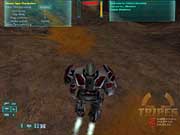
For unorganized public games, it can be tough to get a team to coordinate even simple tasks efficiently. To help this, Tribes 2 introduces a queued task list that will give waypoint updates to all players on the team so that they're kept informed - for example, updates of which parts of the base's defenses need repairs or updates of the location of the injured flag carrier calling for escort. In a similar step toward structured organization, Tribes 2's integrated voice chat has smart features that should help alleviate some of the potential for unnecessary radio chatter. Only two voice channels are ever active at once, and players can mute and unmute teammates from a list. Furthermore, an indicator shows a queue of players trying to speak, so you can know when to quiet down and listen for a second. Skilled teams are sure to leave the designated commander unmuted for quick orders.
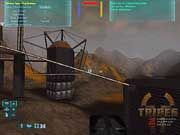
You'll need to be coordinated in games with as many players as Tribes 2 will support - on faster servers, up to 64 players should be able to fight it out in a single map. Fortunately, many of the maps in the game are big enough to accommodate this many people. Furthermore, to cover all the distance quickly, you'll be able to take advantage of Tribes 2's redesigned vehicles. The game will feature three airborne turbogravs and three new ground craft. The ground vehicles are entirely new, and they include an assault tank, a ground scout, and a mobile point base. Heavily armed and armored, the two-person tank can be equipped to fire either a plasma cannon or a heavy mortar. The point base - shielded, yet unarmed - serves as a mobile inventory station that can resupply your team in the field. To round out the support craft, there's the ground scout, which, while unshielded and unarmed, is a very fast reconnaissance buggy.
The most obvious addition to Tribes 2's air force is the bomber - a heavy craft that seats a crew of three (pilot, bombardier, and tailgunner) and carries 40 potent bombs in its belly. The other two air vehicles - the shrike fighter and the heavy transport - come back with few changes. The lightest craft is now designed to do more than scout - with its extreme speed and dual chainguns, this fighter will excel at taking down other air threats and can even strafe. Overall, the turbogravs have been modified to pack more of a punch, but the addition of a guided missile launcher to the medium and heavy suits' arsenals won't make it easy to rule the skies. Luckily, the tailgunner in the two larger craft will be able to pack flare grenades to ward off heat-seeking, surface-to-air missile attacks. As for ground vehicles, their usefulness will presumably depend on the nature of a given map's topography.
Weapons and Items
If you want more mobility than vehicles are likely to give you, don't worry. Skiing - the trademark Tribes maneuver of skating down a hillside and jetpacking up inclines - is back in Tribes 2, and Dynamix has eased the task. By default, you can hold down the spacebar to autoski instead of having to repeatedly tap the key. Skiing was somewhat unbalanced in the original game because it gave heavy suits much more mobility than the designers intended. To help differentiate the classes a bit more, more dramatically steep terrain will be difficult for all but light soldiers to traverse quickly. In addition, air resistance is now taken into account in the physics engine and will slow down the medium and heavy suits.
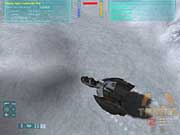
Once you finally get to jump onto a Tribes 2 server, you'll find a number of new game modes, weapons, and items. The game currently includes 11 weapons, two of which are completely new: the missile launcher and the shock lance.
The missile launcher is specially designed to combat flying targets. Once a heat-signature lock is achieved, a missile will track until it impacts or loses target acquisition. To avoid the missile, you can try to throw flare grenades, hide behind terrain, or - if you're not in a vehicle - cut your jumpjets to reduce heat signature. A missile's warhead can cause severe damage, and a shot to a wing may spin an airborne turbograv upside-down and out of control. The missile launcher is powerful, but expect a slow reload time and sparse ammo to balance it out.
The game's new melee weapon, the shock lance, delivers a massive electrical shock to an enemy. Precisely landing a blow on the more thinly shielded rear of a target's armor can lead to a one-strike critical hit. The light-suit assassin inventory default carries a cloaking pack with the shock lance to increase the chance of surprise.
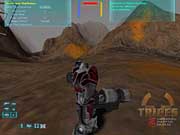
Another one of the new weapons is the sticky mine, though it hasn't been added to the game yet. In addition to the new weapons, there have been a few changes to the old favorites. The blaster, the basic energy weapon, works as it did before except that it now pierces through shield packs, which will make it more suitable as a defensive measure. The distinctive spinfusor, or disk launcher, will also pack an added explosive punch. New reticles with graduated elevation markers should make it easier to judge long-range mortar and grenade launcher shots.
The other weapons that return more or less unchanged include the short-range plasma gun, the chaingun, the sniper rifle, and the energy-draining ELF gun.
The most notable new inventory item in the current build of the game is the cloaking pack. Using energy when activated, the cloaking pack hides you from your opponents by making you translucent. It also acts as a sensor jammer, even when it isn't turned on. It's a great way to make a clean escape with the flag or to sneak up on an unsuspecting enemy for a backstab with the shock lance.
Final Thoughts
In addition to the five original mission types - capture the flag, capture and hold, defend and destroy, find and retrieve, and deathmatch - there will be at least four new or improved game types in Tribes 2. These include the following:
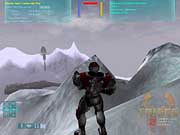
Capture and hold: One of Tribes' more difficult game modes, capture and hold has been revamped in Tribes 2 to make it more lively. Mission objectives, often involving a tower that a team must capture, will now periodically cycle through different locations as the game progresses.
Flag hunter: A furiously fast game similar to various other harvester-type user mods, flag hunter is more than just deathmatch. In flag hunter, you must pick up the flag they drop and escort it to the centrally located nexus when you kill opposing players. On your way to making the point count, you can be sure that you'll be a hot target.
Team flag hunter: Simply, a team game of flag hunter. Here, team control of the nexus itself may be a key strategy.
Rabbit: The flag carrier is "it" - and everyone is out to tag him. The rabbit that survives the longest wins. This was a popular Tribes modification that received the official stamp of approval.
Siege: This is a variation of defend and destroy in which teams seek to secure mission objectives and switch after each mission between defending and attacking.
The development team is still considering various other options and, time allowing, may add more game modes to the list between now and the early beta stage. Overall, the process of precisely balancing the game types will accelerate when beta testing starts around the end of this month.
Dynamix is also still working to optimize the game - especially the graphics engine's new terrain texture system - so each week can make a huge difference at this point. We saw average frame rates double between a recent press preview alpha build and the one shown off at the Tribes 2 gala this last weekend. But even though it needs quite a bit more polish, Tribes 2 already shows the signs of having an even bigger online presence than Tribes has had in the two years since its launch. This could be one of the first squad-based action games to encompass a large enough scale and to give a good sense of coordinated ground combat from a first-person perspective. No armchair generals need apply, since the action in Tribes 2 promises to be so fast - but when the games is released this October, you'll need your wits about you before you charge into the fray.
Got a news tip or want to contact us directly? Email news@gamespot.com
Join the conversation